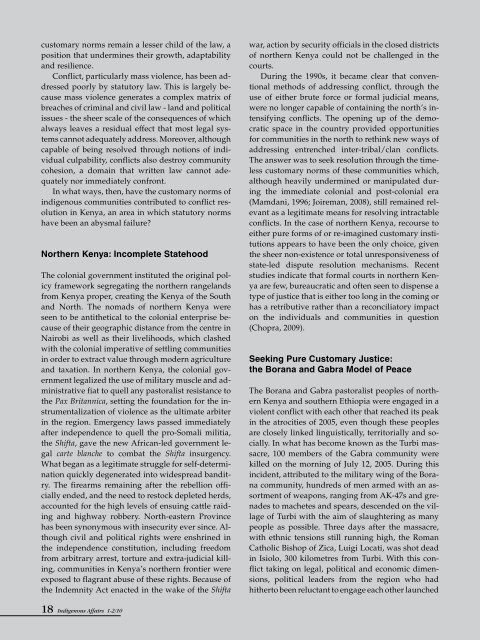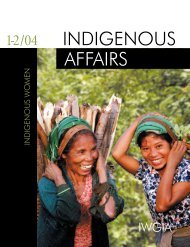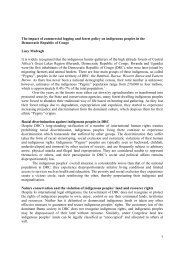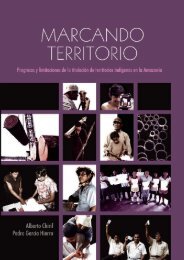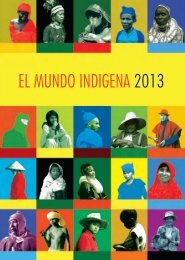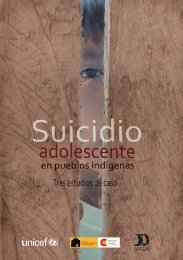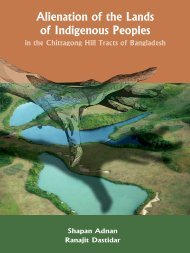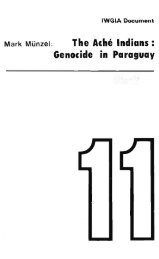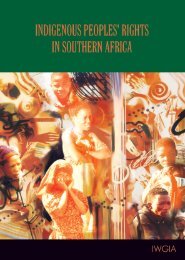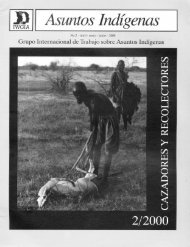Download (pdf) - iwgia
Download (pdf) - iwgia
Download (pdf) - iwgia
Create successful ePaper yourself
Turn your PDF publications into a flip-book with our unique Google optimized e-Paper software.
customary norms remain a lesser child of the law, a<br />
position that undermines their growth, adaptability<br />
and resilience.<br />
Conflict, particularly mass violence, has been addressed<br />
poorly by statutory law. This is largely because<br />
mass violence generates a complex matrix of<br />
breaches of criminal and civil law - land and political<br />
issues - the sheer scale of the consequences of which<br />
always leaves a residual effect that most legal systems<br />
cannot adequately address. Moreover, although<br />
capable of being resolved through notions of individual<br />
culpability, conflicts also destroy community<br />
cohesion, a domain that written law cannot adequately<br />
nor immediately confront.<br />
In what ways, then, have the customary norms of<br />
indigenous communities contributed to conflict resolution<br />
in Kenya, an area in which statutory norms<br />
have been an abysmal failure?<br />
Northern Kenya: Incomplete Statehood<br />
The colonial government instituted the original policy<br />
framework segregating the northern rangelands<br />
from Kenya proper, creating the Kenya of the South<br />
and North. The nomads of northern Kenya were<br />
seen to be antithetical to the colonial enterprise because<br />
of their geographic distance from the centre in<br />
Nairobi as well as their livelihoods, which clashed<br />
with the colonial imperative of settling communities<br />
in order to extract value through modern agriculture<br />
and taxation. In northern Kenya, the colonial government<br />
legalized the use of military muscle and administrative<br />
fiat to quell any pastoralist resistance to<br />
the Pax Britannica, setting the foundation for the instrumentalization<br />
of violence as the ultimate arbiter<br />
in the region. Emergency laws passed immediately<br />
after independence to quell the pro-Somali militia,<br />
the Shifta, gave the new African-led government legal<br />
carte blanche to combat the Shifta insurgency.<br />
What began as a legitimate struggle for self-determination<br />
quickly degenerated into widespread banditry.<br />
The firearms remaining after the rebellion officially<br />
ended, and the need to restock depleted herds,<br />
accounted for the high levels of ensuing cattle raiding<br />
and highway robbery. North-eastern Province<br />
has been synonymous with insecurity ever since. Although<br />
civil and political rights were enshrined in<br />
the independence constitution, including freedom<br />
from arbitrary arrest, torture and extra-judicial killing,<br />
communities in Kenya’s northern frontier were<br />
exposed to flagrant abuse of these rights. Because of<br />
the Indemnity Act enacted in the wake of the Shifta<br />
war, action by security officials in the closed districts<br />
of northern Kenya could not be challenged in the<br />
courts.<br />
During the 1990s, it became clear that conventional<br />
methods of addressing conflict, through the<br />
use of either brute force or formal judicial means,<br />
were no longer capable of containing the north’s intensifying<br />
conflicts. The opening up of the democratic<br />
space in the country provided opportunities<br />
for communities in the north to rethink new ways of<br />
addressing entrenched inter-tribal/clan conflicts.<br />
The answer was to seek resolution through the timeless<br />
customary norms of these communities which,<br />
although heavily undermined or manipulated during<br />
the immediate colonial and post-colonial era<br />
(Mamdani, 1996; Joireman, 2008), still remained relevant<br />
as a legitimate means for resolving intractable<br />
conflicts. In the case of northern Kenya, recourse to<br />
either pure forms of or re-imagined customary institutions<br />
appears to have been the only choice, given<br />
the sheer non-existence or total unresponsiveness of<br />
state-led dispute resolution mechanisms. Recent<br />
studies indicate that formal courts in northern Kenya<br />
are few, bureaucratic and often seen to dispense a<br />
type of justice that is either too long in the coming or<br />
has a retributive rather than a reconciliatory impact<br />
on the individuals and communities in question<br />
(Chopra, 2009).<br />
Seeking Pure Customary Justice:<br />
the Borana and Gabra Model of Peace<br />
The Borana and Gabra pastoralist peoples of northern<br />
Kenya and southern Ethiopia were engaged in a<br />
violent conflict with each other that reached its peak<br />
in the atrocities of 2005, even though these peoples<br />
are closely linked linguistically, territorially and socially.<br />
In what has become known as the Turbi massacre,<br />
100 members of the Gabra community were<br />
killed on the morning of July 12, 2005. During this<br />
incident, attributed to the military wing of the Borana<br />
community, hundreds of men armed with an assortment<br />
of weapons, ranging from AK-47s and grenades<br />
to machetes and spears, descended on the village<br />
of Turbi with the aim of slaughtering as many<br />
people as possible. Three days after the massacre,<br />
with ethnic tensions still running high, the Roman<br />
Catholic Bishop of Zica, Luigi Locati, was shot dead<br />
in Isiolo, 300 kilometres from Turbi. With this conflict<br />
taking on legal, political and economic dimensions,<br />
political leaders from the region who had<br />
hitherto been reluctant to engage each other launched<br />
18 Indigenous Affairs 1-2/10


